Birds are fascinating creatures, and quite special as they are the only animals capable of flight. It is very easy to marvel at the biggest bird on earth like the ostrich, even though it isn’t capable of flight, but these small African birds are even more fascinating, seeing how much they can do with their little body.
These little birds have undergone a very unique evolutionary process that has left them adapted to very particular niches in their ecosystems.
The birds can be hard to spot, both to predators and bird watchers alike, which is to their advantage in the race for survival.
Most small birds having created niches for themselves are thriving with their conservation status being considered the least concern, but this isn’t the case for all small bird species. In this article, I’ll list the 12 small African birds.
Are you thinking about buying binoculars to have a good look at all the magnificent birds of Africa?
1. Southern Penduline Tit
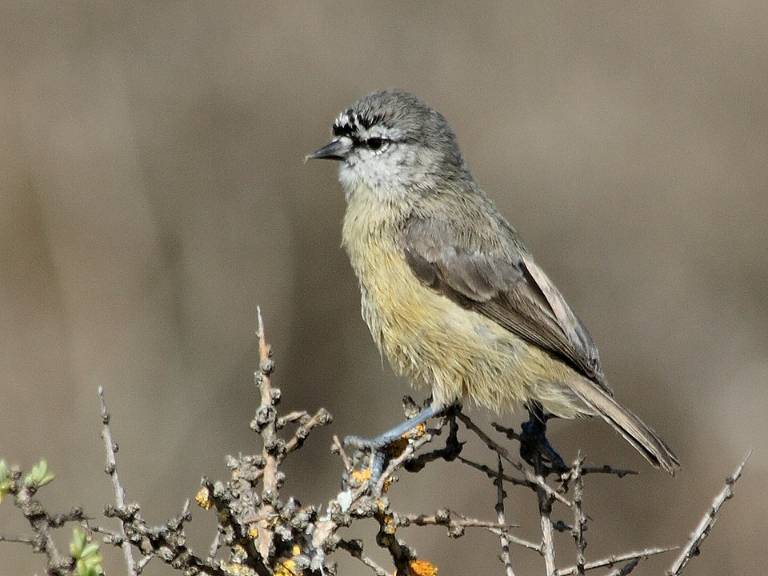
Standing at just 8 to 9 cm (3.14 to 3.54 in) tall, the Southern Penduline Tit, or the Cape Penduline Tit is the smallest bird on the African continent.
These small African birds have grey heads with black and white patterns, small dark-coloured beaks, yellow underparts and dark green backs.
They like feeding on insects and their larvae but will also feed on fruits when their main food is scarce. They will forage in pairs or in groups, hunting for their prey in spider webs and on tree leaves.
These small birds prefer making their nests in tall thorny trees and are highly collaborative when foraging and in raising chicks.
Their nests which are usually oval in shape are made up of silk from the community nesting spider (Stegodyphus spiders), and soft silken fibres from different plants.
Due to predators who might get into the nest when the parent birds aren’t around, their nests are usually built with a false entrance.
They can be found in South Africa, Zimbabwe, Namibia, Botswana, and Angola and prefer Mediterranean-type shrubs, sub-tropical dry shrubland and dry savannah.
2. Pygmy Falcon
The pygmy falcon has the title of the smallest bird of prey in Africa.
Adult pygmy falcons have white underparts, from the feet to the face, males have a grey back, while the females have rufous coloured backs, and flight feathers are spotted black and white with the tail being barred, black and white.
Due to their size, these birds’ diet consists of insects, small reptiles, small birds, and rodents.

Pygmy falcons can be found around different buffalo weaver species as they are obligate users of these weaver birds nests. They enjoy the benefits of the nests without providing any energy costs in their building.
Pygmy falcons usually choose buffalo weaver nests that are big and heavily insulated, and despite them being bird eaters, they largely leave the weavers alone.
They prefer dry bush areas and can be found in South Africa, Angola, South Sudan, Tanzania, Uganda, Somalia and Kenya.
3. Lilian’s Lovebird
The Lilian’s Lovebird is the smallest parrot species on the mainland African continent, standing at just 13 cm (5 in) tall.
This bird is mainly green with an orange head, neck and upper chest, and white eye rings. Their diet is made up of fruits, seeds, flowers, wild rice, and miller.
These birds usually form a homogeneous pair that will mate for life, usually living for about 10-12 years.
They are distributed in countries such as Malawi, Zimbabwe, Tanzania, and Mozambique, and their current population is estimated at just over 20,000 and have more or less vanished South of the Zambezi river.
One of the best places to visit them is the Liwonde National Park in Malawi.
Their numbers have been on a steady decline due to habitat loss to agriculture; they prefer tropical woodland, grassland and savannah.
Did you know that there are plenty of bird books for kids on the market?
4. Neergaard’s Sunbird
The Neergaard’s Sunbird is a small African bird with a relatively short beak and occurs from Mozambique to South Africa along the coastal belt.
The adult male is more spectacularly coloured in comparison to the female which has a dull-coloured plumage.
The adult male has a metallic green throat, head and back, black wings, brown-black tail, black belly, scarlet lower breast, narrow blue collar and yellow pectoral tufts.
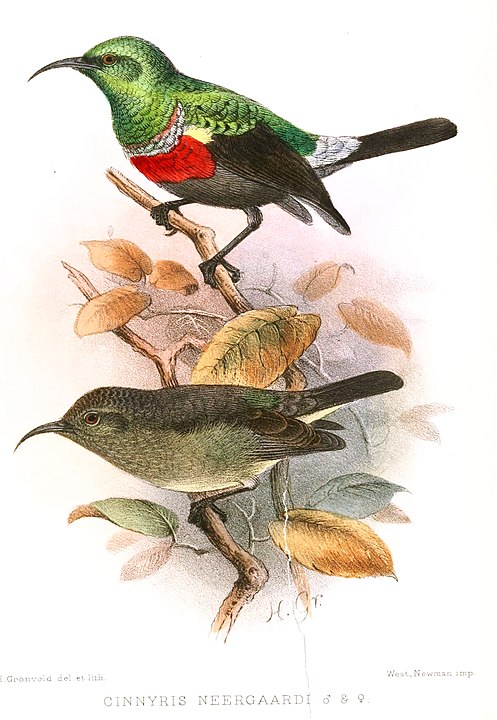
The adult females have grey-brown upper parts and heads, dark brown tail feathers and an olive-brown rump.
The diet mainly consists of nectar from a variety of plants, juice sucked from plants, and various invertebrates. They are common in woodlands, dry forests, and coastal scrublands, and can only be found in low-lying regions
5. African Firefinch
Talk about small African birds! This African Firefinch, aka the blue-billed Firefinch or dark Firefinch, is a small finch in the family Estrildidae standing at just between 10-11 cm ( 3.9 -4.3 in) and weighing about 8.6-11.7g (0.3-0.41 oz).
It has deep carmine red outer tail feathers, upper tail coverts, and rump, the underparts from the chin to the belly are a scarlet red with white spots on the flank and upper breasts.
The nape, neck and crown are lead greys while the beak which is short and pointed has a pink base and a dark grey bill. Its diet mainly consists of a variety of seeds, supplemented by insects.

The bird prefers habitats that are humid and covered by thick vegetation along forest edges.
They can also be found along rivers and streams with thick vegetation, in and around rural villages, and in savannahs that have thorny bushes, acacia woodlands and rank grass.
The male bird usually builds a round nest with a side entrance that is hidden deep within bracken briar undergrowth, ior in long thick grass.
They are distributed in patches across sub-Saharan Africa in the Eastern Cape of South Africa, Mozambique, Tanzania, the D.R.C., Ethiopia to Senegal.
6. Namaqua Dove
The Namaqua Dove is a small pigeon the size of a sparrow standing at 22 cm (8.66 in) tall and weighing on average 40 g(1.41 oz).
Most of its body feathers are grey, apart from the primary flight feathers which are chestnut and the belly feathers which are white.
Adult males usually have black breasts, throat and face with a red and yellow beak, while adult females lack the black feathers, but have a dark grey-red bill.
Young doves resemble females apart from dark blotches on the shoulders and wings.
They are quite terrestrial and will forage for food on the ground, with their diet consisting of small seeds such as those of weeds and grasses.
Their preferred habitats include shrublands, grassy savannahs, and near deserts that have bushes and acacia trees.
They can be found throughout Africa in countries such as, Algeria, Egypt, Benin, Cameroon, Congo, Ethiopia, Kenya, Angola, Zimbabwe, Mozambique to South Africa.
Would you like to learn more about recognizing African bird species? There are plenty of bird books for the African continent available online!
7. Little Brown Bustard
The Little Brown Bustard is the world’s smallest Bustard standing at 45 cm (18 in) tall, and weighing at 600 g (1.3 lbs).
The bird has an overall light brown colour with lighter-coloured underparts. The female has a heavy buff spotting on the breasts, wings and back while the male has a black throat with white spots and a black tuft on the nape.
In-flight both genders show a narrow white wing bar which divides the sandy brown wing covers from the black feathers.
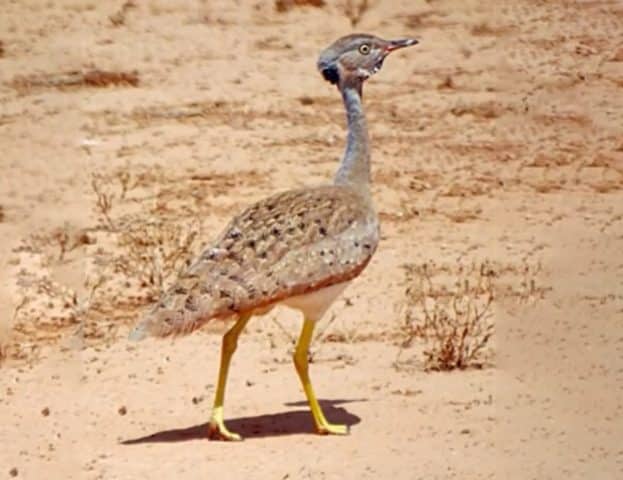
Just like other bustard species, the Little Brown Bustard are terrestrial preferring walking to flying, though they are good fliers.
Their walk is brisk as they forage for food, with their diet consisting of small vertebrates such as lizards, buds, insects and seeds.
Its habitat is up to 1500 m (4921 ft.) above sea level in open thornbush and dry scrubs. They are endemic to the horn of Africa region and can be found in Somalia, and Ethiopia.
8. Red-Backed Mousebird
The Red Backed Mousebird belongs to the order Collidae which has only six species of mousebirds;
- Red Backed Mousebird,
- White-backed Mousebird,
- Speckled Mousebird,
- Red-faced Mousebird,
- white-headed Mousebird,
- and the Blue Naped Mousebird,
- all of which range in size from 27 to 38 cm ( 11 to 15 in), with half of this height being the tail alone.
These birds get the name mousebird from the way they move around or scurry like mice.

They have a distinctive chestnut patch on the back, pale white, short and stubby beaks with a darker base, grey-brown back, lighter underparts and yellow feet.
Their wings are short and round and are not designed for long-distance flight. Their diet consists of seeds both wild and from cultivated farms and berries.
They prefer habitats that are on river borders, thorny shrubs and less dense forests and they can be found in Northern Namibia and Angola.
9. White-Tailed Lark
The White Tailed Lark is a small and compact lark that has black or dark underparts, a bold white eyebrow that runs from in front of the eye to the back of the neck, black breast streaks that contrast sharply with a pale belly, a tail that is dark with white outer feathers that are visible in flight.
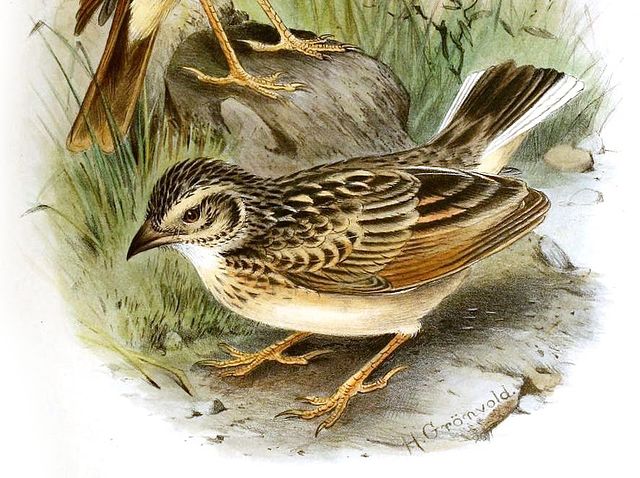
Their diet consists of seeds and insects and their habitats are tropical and subtropical wet lowlands and floodplains.
They can be found around lakes such as lake Victoria and Lake Chad in countries such as Kenya, Chad, Uganda, South Central Ethiopia, Central Tanzania and South Sudan.
10. Kittlitz’s Plover
Kittlitz’s Plover is a very small plover amongst the small African birds that weigh about 35 g (1.23 oz.), and are native to much of Sub-Saharan Africa, the Nile river system and Madagascar.
Both male and female birds have black bills, black legs, and black eyelids with dark brown eyes.
During the breeding season, males have a black bar followed by a narrow white bar on the forecrown with the rest of the crown being brown with sandy tips.
The mantle has a dark grey-brown colour, while the upper parts are a sooty brown with the feathers having margins that are rufous-brown.
The upper throat, chin, face and upper parts are a light yellow colour. The central tail feathers are black and brown getting gradually lighter towards the sides of the tail.
Their diet consists of insects, molluscs and small crustaceans, and they forage in a run-stop-search pattern and will feed day and night, particularly on full moon nights, when they feed until 11 pm.
They feed in social groups, and with other wading birds. Their habitats can be found inland or near coastal salt marshes, alkaline grasslands, and muddy or sandy riverbanks.
11. Bronze Mannikin
Talk about small African birds, this is one of them! 😉
The Bronze Mannikin is the smallest of the four Mannikin species of birds in Africa standing at between 8.5 – 9.2 cm (3.3 – 3.6 in) tall, and weighing an average of 9.5 g (0.33 oz.).
The adult bird has black-brown feathers on the centre of the chest, chin, throat and head, white underparts with barrings on the rump and flank, and grey-brown upperparts.

Its diet is mainly made of seeds both wild and from farmed lands, but will also feed on algae, nectar and termites in times of scarcity. They are native to and distributed across Sub-Saharan Africa in forest margin and savannah habitats.
Are you thinking about buying binoculars to have a good look at all the magnificent birds of Africa?
12. Grey-Capped Social Weaver
The Grey Capped Social Weaver is a small bird standing at about 11-12 cm (4.3-4.7 in) tall, and weighing just 15-26 g (0.54-0.92 oz.).
It has a distinct grey-coloured crown, white eye rings, dark grey bill, pale legs, a bit of black in the wings and a white tail band that is visible when the bird is in flight.
The Grey Capped Weaver’s behaviour closely resembles that of the social weaver, in that they breed in colonies and are monogamous.
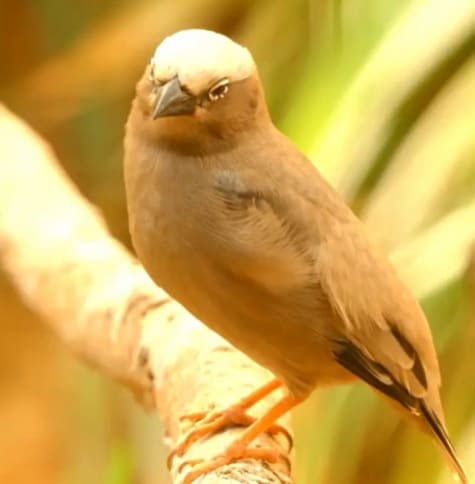
They feed on insects such as grasshoppers, Caterpillars, termites, beetles and grass seeds.
These small African birds have two known subspecies: P. Arnaudi Arnaudi which can be found in Northern Uganda around Mt. Elgon, the Southern part of South Sudan, Central Kenya, Ethiopia and Tanzania. P. Arnaudi Dorsalis which can be found in Tanzania, between the South of Lake Victoria to the top of Lake Malawi.
Their preferred habitats are cultivated regions and dry savannahs.
My Final Conclusion.
I hope to have informed you enough about all of these cute small African birds and if you have any more questions, please feel free to ask them below in the comment section.
You can also join me on my social media pages for more pictures of my African travels or Facebook group.
I wish you happy travels!
Kind regards,
Lizzy
I now have a YouTube channel as well!
YouTube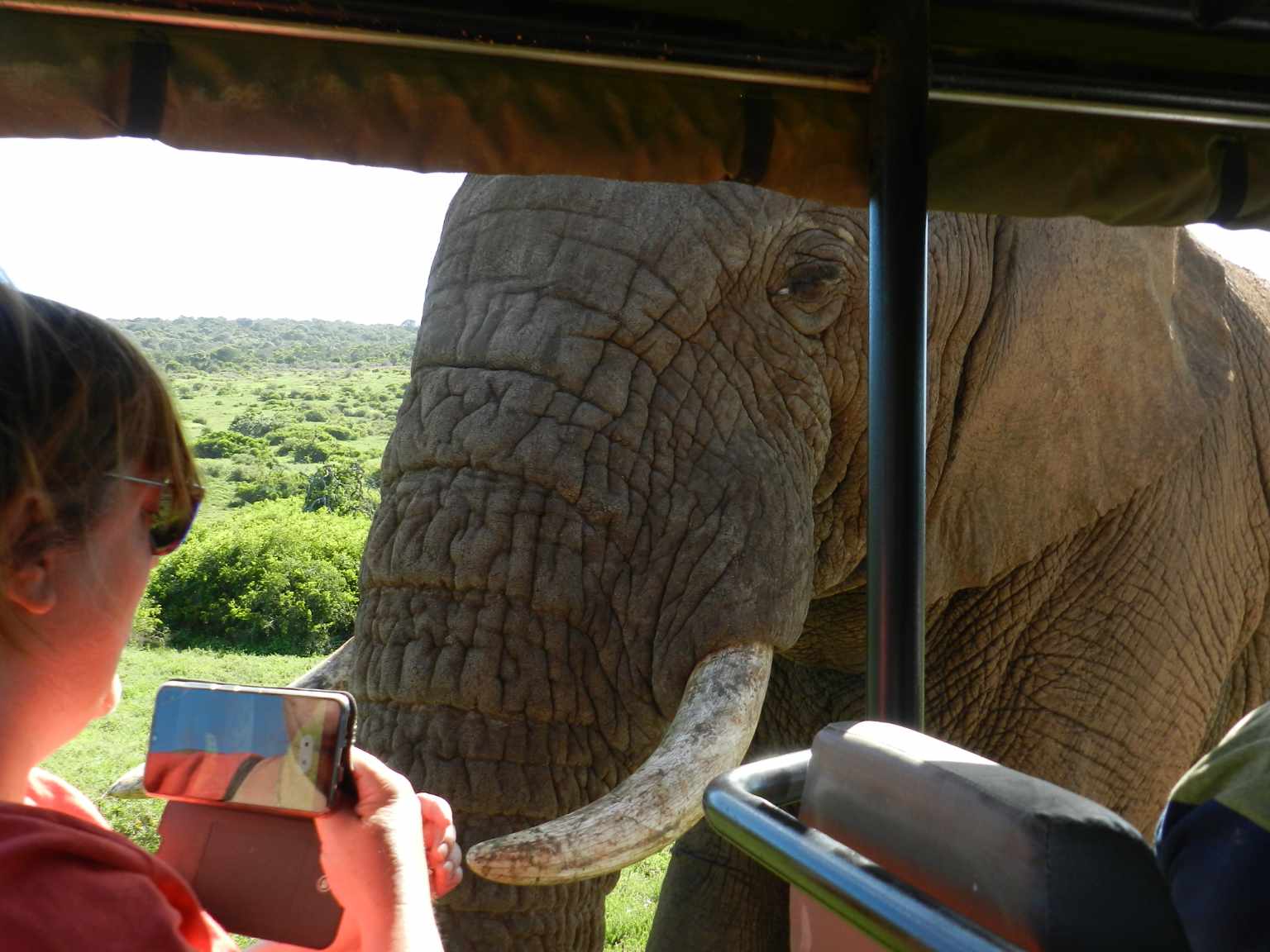
Hello Africa travellers!
Who am I? Well, the least you can say is that I am quite crazy about Africa, its nature, its climate, its culture, and more.
As a young woman in my twenties, I had already traveled to several African countries by traveling along in an overlander on my own and mostly camping ( or glamping ) and just fell in love with the diversity of it all.
So much, so that at the age of 26, I went back to university to study biology, which, unfortunately, I couldn’t finish because of health reasons (yes, I got sick from a tropical disease, oh cynicism). But this did not stop my dream of traveling back to Africa several times, and I still do.
My dream was back then to leave Europe and go study animal behavior, especially the elephants (sure, that’s every girl’s dream haha), but I am also very much intrigued by hyenas and other “ugly African animals“.
So, I “kind of” have a little bit of a scientific approach to my articles, when I write about African birds, for example. And most of all: the passion.
But life goes on, you move from one side of the country to the other, you get sick again and top it off with lower back problems, and before you know it, you are over 50 hahaha!
Now, I still travel to Africa, but take it a bit “easier” than the good old camping days, and stay in comfortable, yet affordable accommodations, together with my husband Wouter.
These are some of the countries I have traveled to: Kenya, Tanzania, Zanzibar, Malawi, Zambia, Zimbabwe, South Africa, Namibia, Botswana, Tunisia, and a little bit of Lesotho LOL .
While clearly not being African territory, but Spanish, I also visited Gran Canaria and Tenerife, and location-wise, I consider them “African”, because of their climate and nature, sue me :-p
The last trip I took was to South Africa in the year 2023, and it sure got the fevers for Africa back! From the Barberton mountains to the Drakensberg and the Southcoast, one month wasn’t enough at all to see the whole country, so we’ll be back! At ease and with a little bit more luxury than in my younger days haha!
I wish you happy travels!
Kind regards
Lizzy

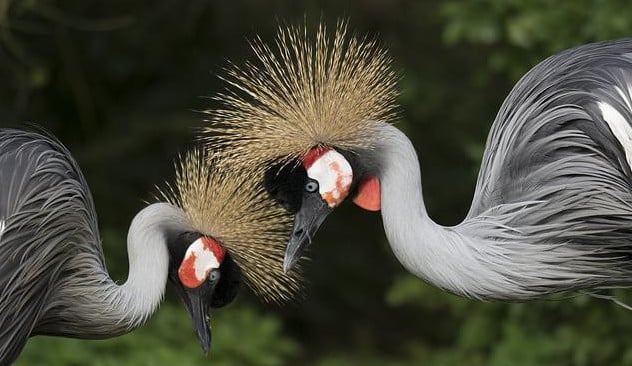
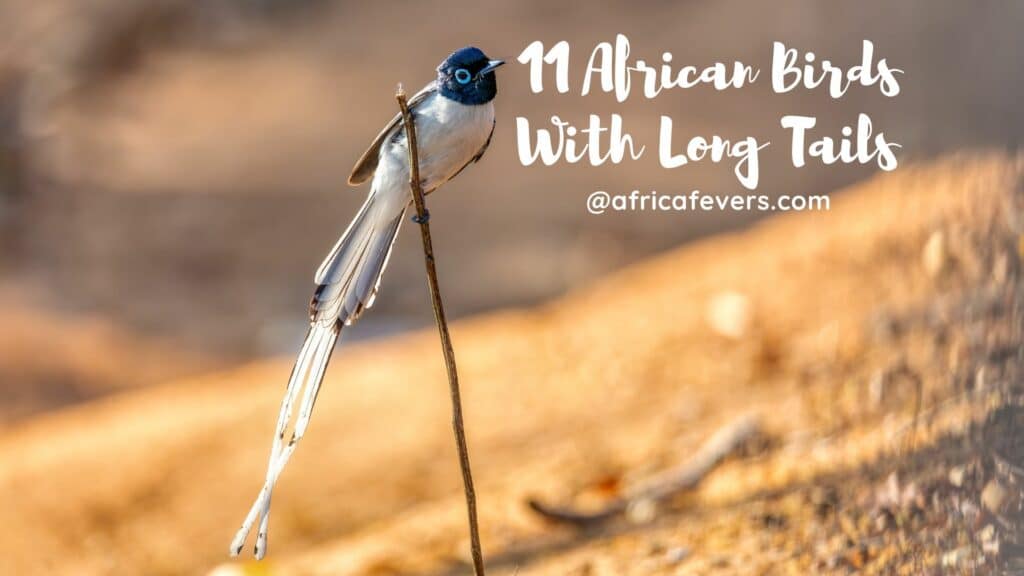
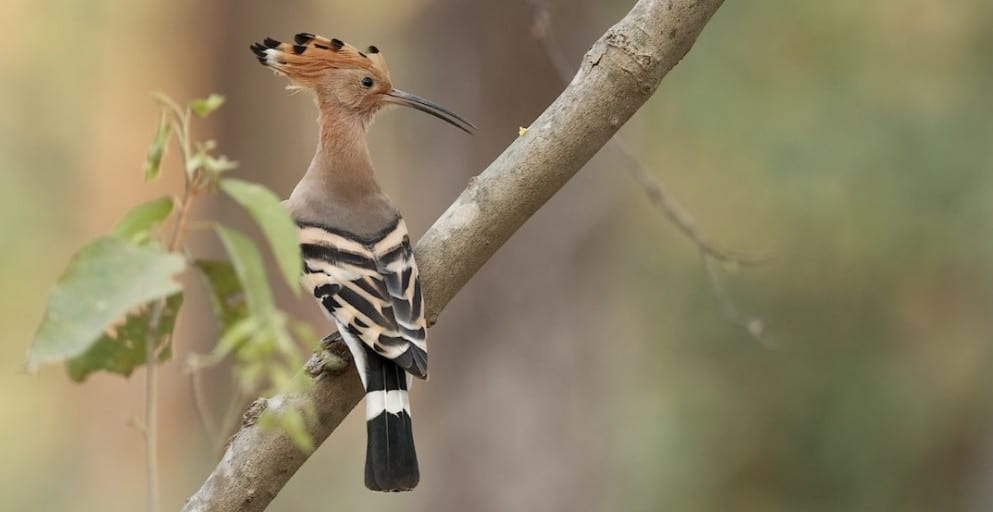




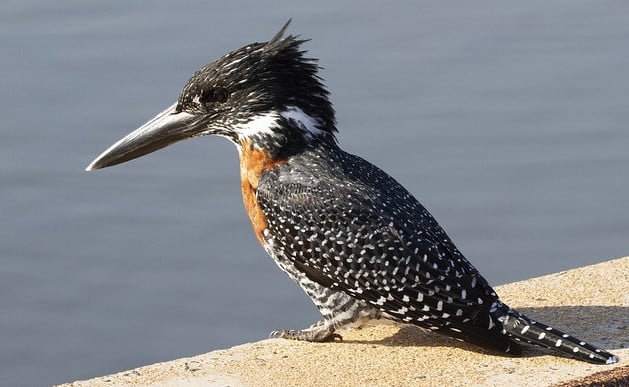


Birds are the most amazing animals I’ve seen. Especially during the summertime (where I live), I see a variety of them pop out of nowhere.
This list of birds was unique- I’ve seen some of them before. But not all of them, so I’m glad to know these birds exist.
Out of the list, my favorite one would have to be Lilian’s Lovebird. They look beautiful to say the least, and one of the best birds in Africa.
On average, do you know how many of them are at Liwonde National Park?
Are there a bunch of them, or do they show up quickly?
I ask if I end up visiting Malawi at some point. If so, I’d love to go see them in person. That would be nice.
Thank you for sharing this list- I found it very helpful.
Hello Eric!
You are welcome and I hope that you will enjoy some birdwatching in Liwonde National Park 😉
It is hard to say how many Lilian’s lovebirds would be at this park exactly because they can go from a total population as high as 20,000 or as low as 10,000.
But I’m sure that you will encounter enough of them to be admired, especially with a good pair of binoculars!
I wish you happy travels!
Kind regards,
Lizzy
I am so happy I stumbled across your page. My son, age 1, absolutely loves bird! It is quite miraculous how his tiny eyes can spot them, even high up.
Anyways, I just wanted to say that your article on these smaller birds was informative and one can really appreciate these small animals once you learn more about them.
I cannot wait to share the following facts I found interesting with my son:
Southern Penduline Tit – Makes its nest from spider webs
Pygmy Falcon – Do not build their own nests but use buffalo weaver nests
Little Brown Bustard – Prefers walking to flying
You have really equipped this mama to raise a tiny bird watcher!
Hello Chrisna!
That’s so cute that your 1-year-old is fascinated by birds! 🙂
Did you know that I have written another blog post on fun facts on birds for kids? You could read that to him as well, I’m sure that he will love it;-)
I’m happy to have informed you!
Kind regards,
Lizzy